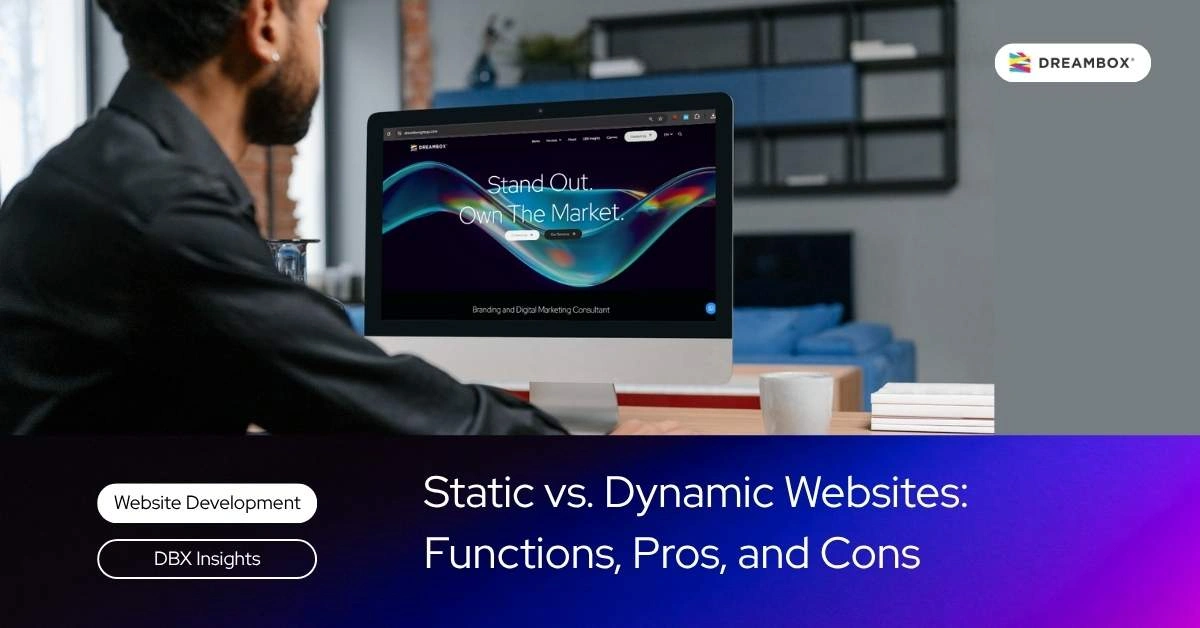Understanding the difference between static and dynamic websites is the first key to building one. This choice determines your site’s flexibility: will its content be fixed (static) or able to change and interact with users (dynamic)? So, which one is most suitable for your business goals?
What Is a Static Website?
A static website is a type of website whose content does not change unless manually adjusted by its developer using HTML and CSS technology. This type of website is best applied for websites with simple functions.
What Is a Dynamic Website?
In contrast to a static website, a dynamic website is one whose content can change automatically. This website type is widely used for sites that require user interaction features.
In its development process, developers use technologies such as PHP, Python, CMS, JavaScript, and Databases.
Comparison Table: Static vs. Dynamic Websites
To assess the difference between static and dynamic websites more practically, here is a comparison table of the two types:
Schedule a free 30-minute branding consultation session with our experts.
| Differentiating Aspect | Static Website | Dynamic Website |
| Content Changes | Manual | Automatic |
| Speed | Very Fast | Slightly slower, depending on website complexity |
| Technology | HTML & CSS | PHP, JavaScript, Database, CMS |
| Interactivity | Limited | Flexible |
| Development Cost | More affordable | More expensive |
Pros and Cons of Static Websites
Choosing the right option between a static and a dynamic website isn’t just about looking at their differences, but also about assessing the pros and cons of each. Here is the breakdown.
Pros of Static Websites
- Fast Loading: Static websites load faster because they are in an HTML format that is ready to be sent to the browser.
- Lower Cost: Static websites do not require complex servers and databases, so development costs can be more affordable.
- Easy to Deploy: Static websites have a simpler file format, making them easier to deploy without needing to install a CMS.
- Compatible with Various Browsers: Despite being simple, static websites are compatible with various browsers, even older versions.
Cons of Static Websites
- Not Flexible: The difference between static and dynamic websites lies in their level of flexibility. For static websites, flexibility is quite limited and cannot be adjusted automatically.
- Requires Manual Edits for Updates: If you want to update content on a static website, you must do so manually.
- Less Suitable for Large-Scale Websites: Static websites are less suitable for manually managing large-scale websites.
- Poor Support for Complex Functionality: Cannot run complex features like logins, search functions, and shopping carts.
Pros and Cons of Dynamic Websites
What about the pros and cons of dynamic websites? Check out the full details below.
Pros of Dynamic Websites
- Content Can Be Updated Automatically and in Real-Time
Content on a dynamic website can be changed automatically because it is connected to a database. - Supports User Interaction (Like Logins, Comments, Transactions)
Dynamic websites enable users to interact with the system through features such as comments, logins, and transactions. - More Flexible for Large-Scale and Complex Needs
Dynamic websites support complex needs, making them suitable for various large-scale websites like e-commerce.
Cons of Dynamic Websites
- Loading Time Tends to Be Slower
Dynamic websites require processing requests by retrieving data from a database, which can result in slightly slower loading times compared to static sites. - Higher Development and Maintenance Costs
Generally, dynamic websites require a development team and regular maintenance, which incurs higher costs. This shows that the difference between static and dynamic websites is quite significant in terms of cost. - Requires a More Powerful Server
Because more processes are occurring, the server must be more powerful. If not, the website’s performance will decline. - Can Be More Prone to Bugs and Errors
Having more complex code makes the website more prone to errors and bugs. If not developed properly, it can also trigger security risks.
Examples of Static and Dynamic Websites
The difference between static and dynamic websites is also visible in their application examples. Here are common examples of static and dynamic website types.
- Examples of Static Websites
Examples of static websites are personal portfolios, company profiles, and product landing pages. These websites typically display static information that is rarely updated. - Examples of Dynamic Websites
Examples of dynamic websites are e-commerce sites, news media, and social media platforms. These types of websites allow users to utilize interactive features.
You can visit this website to see how dynamic the website is, click the following link.
Static or Dynamic: Which Website Do You Need?
Confused about choosing between a static or dynamic website? The answer lies in the primary purpose of your website.
If you need a “digital business card” that is elegant, super-fast, and secure—such as for a portfolio, a company profile site, or an information page that is rarely updated—then a static website is the champion.
However, if your website needs to be “alive” with interactive features like user logins, comment sections, or constantly changing content like an online store or news portal, then a dynamic website is the absolute choice.
Build Your Website with Dreambox
Static and dynamic websites are two types that may serve the same function, but they differ in several aspects. The primary differences between static and dynamic websites lie in their flexibility, cost, interactivity, and the technology used.
If you’re still confused about determining which type of website suits your needs, Dreambox could be the solution! Through our Website Development services, you can get complete support from UI/UX to branding, ready to represent your brand.
For more information about this service, please contact our team. Don’t forget to stop by DBX Insights because we have many interesting articles to enhance your digital strategy.










